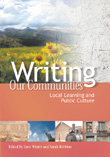 As we head back to school, we face the challenge of building eclectic groups of students into engaged literacy communities. Once the icebreakers are over, what do you do?
As we head back to school, we face the challenge of building eclectic groups of students into engaged literacy communities. Once the icebreakers are over, what do you do?
One great solution is to launch a collaborative inquiry-based writing activity that gets students involved with one another. Working in small groups, students can get to know a few others well and can build strong classroom communities as they explore, create, and reflect on their inquiry task.
Local community inquiry projects offer a strong option for the first weeks of class. Contributors to the NCTE book Writing Our Communities: Local Learning and Public Culture explain in their preface:
We believe that students need to engage the multiple communities that surround them and also that those communities benefit from the energy and enthusiasm that students can bring to active citizenship, where citizenship means recovering critiquing, and actively engaging the world around them. Once teachers encourage their students to research and to write about community, the classroom comes alive in wonderful and unexpected ways. As students learn more about the communities around them, they discover how important keeping community ties and creating new ones can be. (p. xi)What better activity could you hope for in the first days of school than one that encourages creating new ties and strengthening existing ones?
For some classroom activities focusing on local community inquiry, try these resources:
- “Thematic Strands for Studying Community” from the opening of Writing Our Communities describes five different aspects of community that inquiry can focus on.
- “Sharing Stories to Build
Community,” Chapter One from Writing Our Communities by Linda Hadley Stewart, invites students to share a memorable childhood incident as a warm-up activity for deeper community explorations.
- Walt Whitman as a Model Poet: “I Hear My School Singing,” a ReadWriteThink lesson by Writing Our Communities’ contributor Patsy Hamby, asks students to create their own poems after exploring the community at their school. Although published as a secondary lesson plan, the activity to be adapted for younger students.
- Connecting Past and Present: A Local Research Project, a ReadWriteThink lesson by Writing Our Communities’ contributor Linda Templeton, casts students as active archivists—gathering photos, artifacts, and stories for a museum exhibit that highlights one decade in their school’s history.














2 comments:
My favorite first day activity is to ask students to interview each other and then write an introduction to the student interviewed, presenting the high points to the class. It helps me learn more about each student and gives me a writing sample. Every student then knows at least one other person in the class.
We believe that students need to engage the multiple communities that surround them and also that those communities benefit from the energy and enthusiasm that students can bring to active citizenship, where citizenship means recovering critiquing, and actively engaging the world around them. Once teachers encourage their students to research and to write about community, the classroom comes alive in wonderful and unexpected ways. Really enjoy your blog and posts Exhibition Tents Rental Dubai | Tent Rental Dubai | Tents Rental Sharjah | Tents Suppliers Dubai | Tents for Sale in Dubai | Tent Companies in Dubai | Tent for Rent in Abu Dhabi | Outdoor Exhibitions Tents | Swimming Pool Tents and Shades Dubai have a nice day. As students learn more about the communities around them, they discover how important keeping community ties and creating new ones can be.
Post a Comment